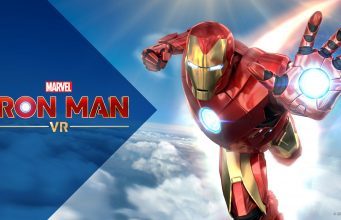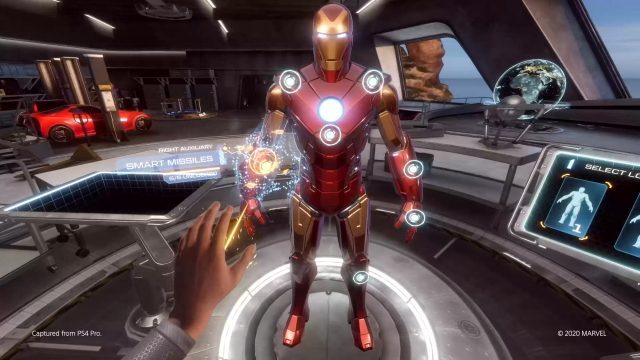
Iron Man VR is far from the first VR superhero game out there—in fact, it isn’t even the first Marvel VR game—but with unique mechanics, strong storytelling, and a full course of content, it’s the first great VR superhero game.
Iron Man VR Details:
Publisher: Sony Interactive Entertainment
Developer: Camouflaj
Available On: PlayStation Store, Blu-ray
Reviewed On: PSVR (PS4 Pro)
Release Date: July 3rd, 2020
Price: $40
Gameplay
‘Iron Man’ may be in the title, but Iron Man VR focuses almost as much on putting you into the suit and tie of the man behind the mask, Tony Stark.
The game explores Stark’s transition from arms dealing profiteer to superhero, and the challenge of leaving that life behind. His past dealings haunt him, quite literally, through the antagonist, Ghost, which drives most of the game’s conflict.
Though the action leans in the arcade direction in function and form, Iron Man VR weaves a worthwhile, well-paced story throughout which gives context to the thrilling flying and explosions.
In opting to make this game, developer Camouflaj took on a challenge that many may not fully appreciate. Iron Man simply wouldn’t be Iron Man without the ability to fly. While we’ve seen plenty of VR games that put players in planes and other flying vehicles, none have managed to bring such exhilarating agility to the table—at least none that have also managed to keep the experience highly comfortable, a feat that Camouflaj should be quite proud of.
True to form, in Iron Man VR, you’ll be getting around almost exclusively with the repulsor jets mounted on your palms. And you control them exactly as you’d expect: thrust with your palms down for lift, back for forward motion, and any other direction you want to go. Double-tapping the PlayStation Move triggers offers an instant speed boost which is both fun and useful throughout the game, especially for quick changes in direction, escaping key enemy attacks, or blasting off from the ground after a ground-pound attack.
Speaking of attacks, you’ve got two primary means of shooting down baddies. The first is your repulsors, which are your basic attack, and the second is your choice of several auxiliary weapons which are more powerful but have a cooldown. Oh and there’s the Unibeam, which functions as your most rare and powerful attack, capable of wiping out the game’s most powerful enemies in short order.
Guns are good, but punching is fun too, and you’ll find the rocket punch and ground pound attacks to be quite useful throughout the game.
For the most part, all of your weapons and capabilities can be swapped and upgraded via points you’ll earn throughout the game’s campaign. To earn extra points, you can tackle optional ‘challenge’ missions (like time trials and wave combat) which are fun and integrated well enough into the core game that they feel like nice bits of extra fun rather than pure padding. All levels and challenges also feature leaderboards and you’re encouraged to play missions again to do well enough to earn the maximum number of upgrade points.
Aside from it being a little too easy to accidentally trigger auxiliary weapons when you wanted to use the basic repulsor, combat works quite fluidly with the game’s flying mechanics. While it’s tempting to always use both hands to attack, you can also fly with one hand while attacking with the other, keeping you mobile while on the offensive.
At first it felt easy to get overwhelmed, but with more practice as the game progressed I started to feel like… well, like a superhero.
While the game’s basic enemies lack character (they are mostly autonomous drones, after all), they all serve a well defined role in the overall combat sandbox, each compelling different tactics and reasons for prioritizing their destruction.
With nothing else, the game’s flying and fighting mechanics would be well executed but surely get old with too much repetition. Fortunately, Iron Man VR wraps it all up in a well-paced story that’s more than just set dressing.
You’ll spend a fair bit of time outside of the suit. Much of it will be hanging out in Stark’s garage where you’ll have frequent interactions with the game’s two artificial intelligence characters. While the ‘AI companion in your ear’ is an entirely overdone trope, Iron Man VR gives the AI characters physical manifestations and spends considerable time building their characters and integrating them into the story, making them far more than a voice shouting instructions into your helmet.
Although the game has you revisit the same locales on occasion, it does so in a smart way that doesn’t feel quite like blatant content recycling. This is also made up for by some interesting one-off environments and bits of gameplay that I didn’t expect to see but add more depth to the experience.
You’ll also see a few ‘boss fight’ scenarios which are generally well executed, save for one which felt a bit too ambitious.
It took me about seven hours to complete the game’s main campaign and a few of the optional challenges. The challenges felt like morsels of extra fun in their own right, and I appreciated that they felt at home in the game’s campaign rather than being in some separate mode; I would have liked to hop into a few more if I had extra time.
Immersion

For a game about masquerading around like a walking, talking fighter jet, Iron Man VR sprinkles thoughtful immersive touches throughout that give character to the game’s world. Things like being able to hear servo motors whirring in your arms as you move the suit, or being able to pull grapes out of the fridge in Stark’s garage and pluck a single grape off the stem to eat, reward the player for spending time outside of the core combat gameplay.
Stark’s garage acts primarily as your mission and upgrade menu, but it manages to feel like much more. In the center of the garage is the suit station where you can view and upgrade your suit with a fully interactive menu.
To the left you’ll find the place where Gunsmith (the AI which ran Stark’s arms-dealing business) tends to hang out. There you can also find an interactive touchscreen table which catalogues the game’s enemies. On the right you’ll find the globe from which you launch missions, which is also where Friday (Stark’s assistant AI) usually hangs out.
Behind you there’s a loft area with a handful of mini-game-like interactive stations like weights, boxing gloves, a free-throw arcade machine, and more.
Though flying around in the game certainly feels thrilling thanks to your speed and agility, it feels less immersive than other parts of the game because you’re ultimately shooting at far away enemies and generally having less intricate interactions. The aesthetic of the interface (with its huge weapon reticles which are easy to mix up) comes off as a bit too arcade-ish, though they may be a necessary concession for the game’s visually busy shoot-and-smash gameplay.
Luckily, combat is peppered with occasional interactive moments that help keep immersion up. You’ll do things like seal doors shut with your repulsor beams, remove power cores to shut things down, or freeze things with coolant. These are typically near-field interactions that let you get more hands-on with the world even while you’re otherwise cruising around and blowing stuff up at a distance.
Speaking of immersion, one of the game’s early suit-up sequences felt so cool that I wished it was used more than once in the game.
Fairly frequent and long loading screens unfortunately prevent the game’s larger moments from flowing smoothly together, though I’m glad they at least added some stuff to read in the loading screen and little particles at your feet to play with.
Comfort

Considering how fast and far Iron Man VR moves the player around, I didn’t expect it would feel perfectly comfortable. And yet, I was able to play the game easily for an hour or more without feeling any issues. There was the occasional moment which induced a sense of lurching motion, but these were rare and, surprisingly, mostly found in the grounded cinematic moments.
Other VR games have featured free-form flying (Stormland comes to mind) but Iron Man VR is by far the fastest and most agile. I really enjoyed being able to ground-pound from the air all the way down to the earth below, and then blast off with a boost to gain hundreds of feet of altitude in seconds, all while feeling comfortable.
The feeling of moving with such comfortable freedom is something that few other VR games have managed, and it feels like an achievement on Camouflaj’s part. It’s clear the studio has taken much care in designing specifically for flying comfort; that made it surprising to see a few minor comfort mistakes (like the HUD boot-up sequence which initially renders some elements too close for comfort, and a few cinematic moments where the game moves you around).
Beyond the achievement in flying comfort, Camouflaj also did an exceptional job building around the limitations of PSVR’s tracking. There were vanishingly few moments where I remember even thinking about the tracking, and I found absolutely no tracking issues during the flying and shooting gameplay.
While the game employs snap-turning and peripheral blinders by default, those who want the unbridled experience can enable smooth turning and disable blinders.
The post ‘Iron Man VR’ Review – VR Gets Its First Great Superhero Game appeared first on Road to VR.
from Road to VR https://ift.tt/2NOVfJ0
via IFTTT
No comments:
Post a Comment